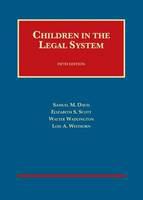
Children in the Legal System
by Samuel Davis, Elizabeth Scott, Walter Wadlington, Lois Weithorn
ISBN-10: 1609302362
ISBN-13: 9781609302368
$246.00
Book Specs
Trade Cloth
Foundation Press
Published on
Dec 23, 2013
Edition
5th Edition
Dimensions
7.75x2.25x10.00 Inches
Weight
5.36 Pounds
About the Book
This Edition has been thoroughly updated with the latest cases, statutory references, and scholarly commentary. It also includes coverage of recent Supreme Court decisions such as:
- Miller v. Alabama/Jackson v. Hobbs (2012), in which the Court held that mandatory imposition of a sentence of life without parole in the case of one who was a juvenile at the time of the offense violates the Eighth Amendment''s prohibition against cruel and unusual punishment
- Graham v. Florida (2010), Miller''s predecessor, in which the Court held that imposition of a sentence of LWOP on a juvenile for a nonhomicide offense violated the Eighth Amendment
- Florida v. Harris (2013), in which the Court, although in an adult, non-school search context, held that an alert by a trained, drug-sniffing dog constitutes a presumption of probable cause to search
- J.D.B. v. North Carolina (2011), in which the Court held that a juvenile''s age is a factor that can be taken into account in determining whether one is "in custody" for Miranda and interrogation purposes
- Stafford Unified School District No. 1 v. Redding (2009), in which the Court held that a strip search of a 13-year-old middle school student violated the Fourth Amendment''s prohibition against unreasonable search and seizure
- Adoptive Couple v. Baby Girl (2013), in which the Court held that the preferences given to members of an Indian child''s family, members of the child''s tribe, or other Indian families, under the federal Indian Child Welfare Act, do not apply where there is no alternative party seeking to adopt the child.
The 5th edition has retained the basic overall organizational structure of the previous edition, with one exception. Chapters 5 through 7, which focus on the legal response to child maltreatment, have been reorganized as follows: Chapter 5 addresses the substantive standards defining child abuse or neglect; Chapter 6 deals with processes characterizing the responses of the dependency and criminal justice systems to suspected child abuse or neglect; and Chapter 7 addresses various dispositions in child maltreatment cases. Within each chapter, substantial new material has been incorporated into the treatment of each topic. For example, Chapter 5 includes special attention to issues such as: specificity versus vagueness in construction of child maltreatment statutes; the line between corporal punishment and physical abuse; the relationships among poverty, race, homelessness, and neglect; the challenges of defining and identifying emotional or psychological maltreatment; and the interplay between domestic violence and child maltreatment. At the same time, Chapter 5 retains and updates this casebook''s distinctive in-depth examination of the appropriate legal responses to a range of medical neglect problems. Chapter 6 follows the processing of cases through the dependency and criminal justice systems respectively, examining topics relating to reporting statutes, summary removal, state liability for failure to protect, and constitutional and evidentiary issues encountered in criminal prosecution of alleged child maltreatment. Chapter 7 examines historical shifts in federal and state policy regarding child welfare system dispositional alternatives, considers the implications of the recent findings of developmental neuroscience for child protection policy reform, and contains materials that allow for critical analysis of a range of issues relating to the foster care system and legal mechanisms for the termination of parental rights. One of the distinguishing characteristics of this book, which the authors have retained in this edition, is its breadth of coverage and degree of flexibility in teaching. It deals with every aspect of how the law relates to minors, from free expression in school and other school-related issues to child custody, to private law (e.g.. torts and contracts), to the juvenile justice system (i.e., delinquency and the operation of criminal justice principles to juvenile justice), to abuse and neglect (including medical neglect), to termination of parental rights, to foster care, to adoption, to the status of children as children (i.e., children''s "rights"). For that reason, the book lends itself to use in any number of courses that might be styled "Juvenile Law," or "Juvenile Justice," or "Juvenile and Family Law," or, indeed, "Children in the Legal System" or "Children and the Law." As mentioned below, the flexibility of the book lends itself to varying numbers of credit hours. The book contains a unique blend of cases, statutory materials, and scholarly commentary, including those from the social sciences in addition to law, in such a way that the teacher can draw on a number of sources in examining and teaching about any subject area covered in the book. No supplementary materials are needed; everything is in one book. The organization of the book is an important pedagogical tool as well. It is organized to flow from one area to the next as it explores the overall relationship between the state, parents, and the child, understanding, of course, that a professor in a given course might choose to skip over some parts of the material in the interest of time and coverage. It lends itself particularly to a 2- or 3-hour course, depending on the nature of the course and what the professor chooses to cover. Each course that is taught around the country using this book, whether in law schools or graduate school or even in the undergraduate classroom, will be tailor-made and suited to the particular professor''s preferences and emphases and the interests of the students.
For those who adopt the book, a Teacher''s Manual is furnished to serve as a helpful guide in using the book in the classroom from day to day. In addition, occasional electronic updates are furnished to teachers, highlighting recent developments and cases, particularly decisions by the U.S. Supreme Court.
